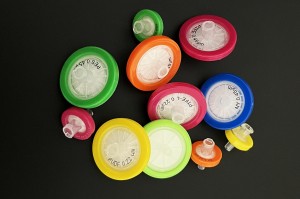How to Choose a Syringe Filter
The main purpose of syringe filters is to filter liquids and remove particles, sediments, microorganisms, etc. They are widely used in biology, chemistry, environmental science, medicine, and pharmaceuticals. This filter is widely popular for its excellent filtration effect, convenience and efficiency. However, choosing the right syringe filter is not easy and requires understanding the characteristics of various filter membranes and other related factors. This article will explore the uses of needle filters, the characteristics of different membrane materials, and how to make the right choice.
-
The pore size of the filter membrane
1) Filter membrane with a pore size of 0.45 μm: used for regular sample mobile phase filtration and can meet general chromatographic requirements.
2) Filter membrane with a pore size of 0.22μm: It can remove extremely fine particles in samples and mobile phases as well as remove microorganisms.
-
Diameter of filter membrane
Generally, the commonly used filter membrane diameters are Φ13μm and Φ25μm. For sample volumes of 0-10ml, Φ13μm can be used, and for sample volumes of 10-100ml, Φ25μm can be used.
Characteristics and applications of several commonly used filter membranes:
-
Polyethersulfone (PES)
Features: Hydrophilic filter membrane has the characteristics of high flow rate, low extractables, good strength, does not adsorb proteins and extracts, and has no pollution to the sample.
Applications: Designed for biochemistry, testing, pharmaceutical and sterile filtration.
-
Mixed cellulose esters (MCE)
Features: Uniform pore size, high porosity, no media shedding, thin texture, low resistance, fast filtration speed, minimal adsorption, low price and cost, but not resistant to organic solutions and strong acid and alkali solutions.
Application: Filtration of aqueous solutions or sterilization of heat-sensitive preparations.
-
Nylon membrane (Nylon)
Features: Good temperature resistance, can withstand 121℃ saturated steam hot pressure sterilization for 30 minutes, good chemical stability, can withstand dilute acids, dilute alkali, alcohols, esters, oils, hydrocarbons, halogenated hydrocarbons and organic oxidation A variety of organic and inorganic compounds.
Application: Filtration of aqueous solutions and organic mobile phases.
-
Polytetrafluoroethylene (PTFE)
Features: The widest chemical compatibility, able to withstand organic solvents such as DMSO, THF, DMF, methylene chloride, chloroform, etc.
Application: Filtration of all organic solutions and strong acids and bases, especially strong solvents that other filter membranes cannot tolerate.
-
Polyvinylidene fluoride membrane (PVDF)
Features: The membrane has high mechanical strength, good heat resistance and chemical stability, and low protein adsorption rate; it has strong negative electrostatic properties and hydrophobicity; but it cannot tolerate acetone, dichloromethane, chloroform, DMSO, etc.
Application: Hydrophobic PVDF membrane is mainly used for gas and steam filtration, and high-temperature liquid filtration. Hydrophilic PVDF membrane is mainly used for sterile treatment of tissue culture media and solutions, high-temperature liquid filtration, etc.
Post time: Oct-12-2023


